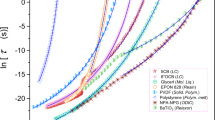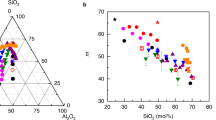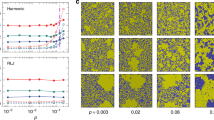Abstract
Understanding the origin of the dramatic temperature and density dependence of the relaxation time of glass-forming liquids is a fundamental challenge in glass science. The recently established ‘density-scaling’ relation quantifies the relative importance of temperature and density for the relaxation time in terms of a material-dependent exponent. We show that this exponent for approximate single-parameter liquids can be calculated from thermoviscoelastic linear-response data at a single state point, for instance an ambient-pressure state point. This prediction is confirmed for the van der Waals liquid tetramethyl-tetraphenyl-trisiloxane. Consistent with this, a compilation of literature data for the Prigogine–Defay ratio shows that van der Waals liquids and polymers are approximate single-parameter systems, whereas associated and network-forming liquids are not.
This is a preview of subscription content, access via your institution
Access options
Subscribe to this journal
Receive 12 print issues and online access
$209.00 per year
only $17.42 per issue
Buy this article
- Purchase on Springer Link
- Instant access to full article PDF
Prices may be subject to local taxes which are calculated during checkout



Similar content being viewed by others
References
Debenedetti, P. G. Supercooled glassy water. J. Phys. Condens. Matter 15, R1669–R1726 (2003).
Angell, C. A. Insights into phases of liquid water from study of its unusual glass-forming properties. Science 319, 582–587 (2008).
Pedersen, U. R., Bailey, N. P., Schrøder, T. B. & Dyre, J. C. Strong pressure–energy correlations in van der Waals liquids. Phys. Rev. Lett. 100, 015701 (2008).
Schrøder, T. B., Bailey, N. P., Pedersen, U. R., Gnan, N. & Dyre, J. C. Pressure–energy correlations in liquids. III. Statistical mechanics and thermodynamics of liquids with hidden scale invariance. J. Chem. Phys. 131, 234503 (2009).
Gnan, N., Schrøder, T. B., Pedersen, U. R., Bailey, N. P. & Dyre, J. C. Pressure–energy correlations in liquids. IV. ”Isomorphs” in liquid phase diagrams. J. Chem. Phys. 131, 234504 (2009).
Ellegaard, N. L. et al. Single-order-parameter description of glass-forming liquids: A one-frequency test. J. Chem. Phys. 126, 074502 (2007).
Davies, R. O. & Jones, G. O. Thermodynamic and kinetic properties of glasses. Adv. Phys. 2, 370–410 (1953).
Prigogine, I. & Defay, R. Chemical Thermodynamics (Longmans Green and Co., 1954).
Goldstein, M. Some thermodynamic aspects of the glass transition: Free volume, entropy, and enthalpy theories. J. Chem. Phys. 39, 3369–3374 (1963).
Moynihan, C. T. & Gupta, P. K. Order parameter model for structural relaxation in glass. J. Non-Cryst. Solids 29, 143–158 (1978).
Berg, J. I. & Cooper, A. R. Linear non-equilibrium thermodynamic theory of glass-transition kinetics. J. Chem. Phys. 68, 4481–4485 (1978).
Hodge, I. M. Enthalpy relaxation and recovery in amorphous materials. J. Non-Cryst. Solids 169, 211–266 (1994).
Nieuwenhuizen, Th. M. Ehrenfest relations at the glass transition: Solution to an old paradox. Phys. Rev. Lett. 79, 1317–1320 (1997).
Wondraczek, L., Krolikowski, S. & Behrens, H. Relaxation and Prigogine–Defay ratio of compressed glasses with negative viscosity-pressure dependence. J. Chem. Phys. 130, 204506 (2009).
Lion, A. & Peters, J. Coupling effects in dynamic calorimetry: Frequency-dependent relations for specific heat and thermomechanical responses—a one-dimensional approach based on thermodynamics with internal state variables. Thermochim. Acta 500, 76–78 (2010).
Angell, C. A., Ngai, K. L., McKenna, G. B., McMillan, P. F. & Martin, S. W. Relaxation in glassforming liquids and amorphous solids. J. Appl. Phys. 88, 3113–3157 (2000).
Dyre, J. C. The glass transition and elastic models of glass-forming liquids. Rev. Mod. Phys. 78, 953–972 (2006).
Cavagna, A. Supercooled liquids for pedestrians. Phys. Rep. 476, 51–124 (2009).
Floudas, G., Paluch, M., Grzybowski, A. & Ngai, K. L. Molecular Dynamics of Glass-Forming Systems (Advances in Dielectrics, Springer, 2010).
Berthier, L., Biroli, G., Bouchaud, J-P., Cipelletti, L. & van Saarloos, W. (eds). Dynamical heterogeneities in glasses, colloids, and granular media. Oxford Univ. Press (in the press).
Alba-Simionesco, C., Cailliaux, A., Alegria, A. & Tarjus, G. Scaling out the density dependence of the α relaxation in glass-forming polymers. Europhys. Lett. 68, 58–64 (2004).
Dreyfus, C., Le Grand, A., Gapinski, J., Steffen, W. & Patkowski, A. Scaling the α-relaxation time of supercooled fragile organic liquids. Eur. Phys. J. B 42, 309–319 (2004).
Casalini, R. & Roland, C. M. Thermodynamical scaling of the glass transition dynamics. Phys. Rev. E 69, 062501 (2004).
Roland, C. M., Hensel-Bielowka, S., Paluch, M. & Casalini, R. Supercooled dynamics of glass-forming liquids and polymers under hydrostatic pressure. Rep. Prog. Phys. 68, 1405–1478 (2005).
Ferrer, M. L. et al. Supercooled liquids and the glass transition: Temperature as the control variable. J. Chem. Phys. 109, 8010–8015 (1998).
Roland, C. M. Relaxation phenomena in vitrifying polymers and molecular liquids. Macromol 43, 7875–7890 (2010).
Bridgman, P. W. Viscosities to 30,000 kg/cm2. Proc. Am. Acad. Arts Sci. 77, 117–128 (1949).
Roland, C. M., Casalini, R., Bergman, R. & Mattsson, J. Role of hydrogen bonds in the supercooled dynamics of glass-forming liquids at high pressures. Phys. Rev. B 77, 012201 (2008).
Coslovich, D. & Roland, C. M. Density scaling in viscous liquids: From relaxation times to four-point susceptibilities. J. Chem. Phys. 131, 151103 (2009).
Schrøder, T. B., Pedersen, U. R., Bailey, N. P., Toxvaerd, S. & Dyre, J. C. Hidden scale invariance in molecular van der Waals liquids: A simulation study. Phys. Rev. E 80, 041502 (2009).
Casalini, R., Mohanty, U. & Roland, C. M. Thermodynamic interpretation of the scaling of the dynamics of supercooled liquids. J. Chem. Phys. 125, 014505 (2006).
de Groot, S. R. & Mazur, P. Non-Equilibrium Thermodynamics (North-Holland, Amsterdam, 1962).
Christensen, T., Olsen, N. B. & Dyre, J. C. Conventional methods fail to measure c p(ω) of glass-forming liquids. Phys. Rev. E 75, 041502 (2007).
Niss, K., Christensen, T. & Dyre, J. C. Measuring the dynamic thermal expansivity of molecular liquids near the glass transition. Preprint at http://arXiv.org/abs/1103.4104 (2011).
Christensen, T. & Olsen, N. B. A rheometer for the measurement of a high shear modulus covering more than seven decades of frequency below 50 kHz. Rev. Sci. Instrum. 66, 5019–5031 (1995).
Christensen, T. & Olsen, N. B. Determination of the frequency-dependent bulk modulus of glycerol using a piezoelectric spherical shell. Phys. Rev. B 49, 15396–15399 (1994).
Birge, N. O. & Nagel, S. R. Specific-heat spectroscopy of the glass-transition. Phys. Rev. Lett. 54, 2674–2677 (1985).
Jakobsen, B., Olsen, N. B. & Christensen, T. Frequency-dependent specific heat from thermal effusion in spherical geometry. Phys. Rev. E 81, 061505 (2010).
Bauer, C. et al. Capacitive scanning dilatometry and frequency-dependent thermal expansion of polymer films. Phys. Rev. E 61, 1755–1764 (2000).
Roe, R. J. Thermodynamics of glassy state with multiple order parameters. J. Appl. Phys. 48, 4085–4091 (1977).
Moynihan, C. T. & Lesikar, A. V. Comparison and analysis of relaxation processes at the glass-transition temperature. Ann. N.Y. Acad. Sci. 371, 151–169 (1981).
Takahara, S., Ishikawa, M., Yamamuro, O. & Matsuo, T. Structural relaxations of glassy polystyrene and o-terphenyl studied by simultaneous measurement of enthalpy and volume under high pressure. J. Phys. Chem. B 103, 792–796 (1999).
Schmelzer, J. W. P. & Gutzow, I. The Prigogine–Defay ratio revisited. J. Chem. Phys. 125, 184511 (2006).
Banerjee, R., Modak, S. K. & Samanta, S. Glassy phase transition and stability in black holes. Eur. Phys. J. C 70, 317–328 (2010).
Pick, R. M. The Prigogine–Defay ratio and the microscopic theory of supercooled liquids. J. Chem. Phys. 129, 124115 (2008).
Liebl, C., Lion, A., Kolmeder, S. & Peters, J. Representation of the glass-transition in mechanical and thermal properties of glass-forming materials: A three-dimensional theory based on thermodynamics with internal state variables. J. Mech. Phys. Solids 58, 1338–1360 (2010).
Javaheri, M. R. H & Chamberlin, R. V. A free-energy landscape picture and Landau theory for the dynamics of disordered materials. J. Chem. Phys. 125, 154503 (2006).
Lesikar, A. V. & Moynihan, C. T. Some relations connecting volume and enthalpy relaxation in the order parameter model of liquids and glasses. J. Chem. Phys. 72, 6422–6423 (1980).
Gnan, N., Maggi, C., Schrøder, T. B. & Dyre, J. C. Predicting the effective temperature of a glass. Phys. Rev. Lett. 104, 125902 (2010).
Igarashi, B. et al. A cryostat and temperature control system optimized for measuring relaxations of glass-forming liquids. Rev. Sci. Instrum. 79, 045105 (2008).
Acknowledgements
The Centre for Viscous Liquid Dynamics ‘Glass and Time’ is sponsored by the Danish National Research Foundation (DNRF). Work at NRL is supported by Office of Naval Research. URP is supported by The Danish Council for Independent Research in Natural Sciences.
Author information
Authors and Affiliations
Contributions
U.R.P. and K.N. conceived the project. D.G., U.R.P., B.J., J.C.D. and K.N. wrote the paper with input from C.M.R. D.G., U.R.P., and K.N. did the main data analysis. T.H. measured the shear modulus and compressibility and did the raw data analysis. B.J. and T.C. measured the heat capacity and did the raw data analysis. K.N. measured the expansion coefficient and did the raw data analysis. T.C. and N.B.O. conceived and developed the four thermoviscoelastic measuring techniques used. D.G., D.F. and R.C. measured the high-pressure data and did the scaling data analysis. U.R.P., N.P.B., T.C., T.B.S. and J.C.D. supplied the theoretical background for the project, which was coordinated by K.N.
Corresponding author
Ethics declarations
Competing interests
The authors declare no competing financial interests.
Supplementary information
Supplementary Information
Supplementary Information (PDF 192 kb)
Rights and permissions
About this article
Cite this article
Gundermann, D., Pedersen, U., Hecksher, T. et al. Predicting the density-scaling exponent of a glass-forming liquid from Prigogine–Defay ratio measurements. Nature Phys 7, 816–821 (2011). https://doi.org/10.1038/nphys2031
Received:
Accepted:
Published:
Issue Date:
DOI: https://doi.org/10.1038/nphys2031
This article is cited by
-
Excess-entropy scaling in supercooled binary mixtures
Nature Communications (2020)
-
Black hole chemistry and holography in generalized quasi-topological gravity
Journal of High Energy Physics (2019)
-
Evidence of a one-dimensional thermodynamic phase diagram for simple glass-formers
Nature Communications (2018)
-
Experimental evidence of high pressure decoupling between charge transport and structural dynamics in a protic ionic glass-former
Scientific Reports (2017)
-
Thermodynamics of freezing and melting
Nature Communications (2016)



